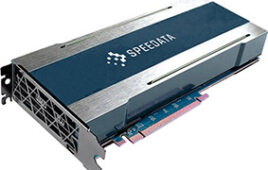Trends in Chromatography Data System Software Development
Emerging changes in the global lab will have a profound influence on future CDS development
New business and technical developments are impacting laboratories at a faster and faster pace. These developments are having a significant impact on evolving
laboratory software applications, especially the chromatography data system, or CDS, in ways few could have predicted. This article will review some of the more pervasive new influences on CDS evolution and the approaches taken by CDS suppliers to deal with them, focusing on how data input from newer instrumentation is influencing CDS development.
One of the earliest laboratory software applications to experience commercialization was the CDS. With the widespread adoption of liquid and gas chromatography instruments throughout laboratories worldwide over the past 30 years, the CDS has followed suit and become a well-accepted technique. From a standpoint of the basic functions it renders, the CDS of today has not substantially changed from its intrinsic design of the 1970s — all CDS today are able to acquire the chromatograph detector signal as a function of injection time and also can peak detect, integrate, calculate results and automate instrument operations of various vendor equipment (autosampler, instrument pump, instrument ovens and other related devices).
While CDS functions have not changed substantially over the past few years, they have, for the most part, been enhanced with new capabilities. These enhancements have been driven by the growth in liquid chromatographs (LC) and gas chromatographs (GC), and also the changes in computer hardware and operating systems. Many of the earliest CDS products were originally designed prior to technology standardizations on computers and operating systems. Today, however, they are generally all PC-based and operate on Microsoft Windows operating system platforms.
Now, as we are firmly entrenched in the new millennia, is CDS development likely to remain the same or are there newer drivers likely to influence the direction of CDS development? While there are expected to be continuing technology innovations in computer hardware and software, there are other emerging changes in the global laboratory environment will have a profound influence on CDS development. This article will review some of the emerging influences and suggest what effect they will play on future CDS development.
The need for speed
Proper data acquisition to sufficiently digitize chromatography data has been a fundamental requirement in any CDS. While peak integration algorithms will differ among CDS vendors, they all
are based on obtaining an optimal number of data points to sufficiently characterize the chromatography detection signal of a component peak. In general, if the CDS does not have the minimum number of digital points, the calculated peak areas, peak heights and baselines can be prone to error.
Many CDS generate satisfactory quantitation provided that they can produce digitizations on the order of 10 to 40 points across a peak. As long as the data collection would provide this number of digital points, the CDS would be able to satisfactorily perform its calculations. In the case of a CDS analog-to-digital converter, the A/D’s sampling rate must produce an appropriate amount of digital data for the CDS to process. Many early generation analog-to-digital converters would generate sampling rates of 50 to 60 Hz. However, these sampling rates, combined with their early-generation CDS, may not be sampling fast enough to correctly handle the narrow “faster” peaks (narrower peak widths) from newer GC and LC instrumentation.
Some of the detectors used in newer chromatography instruments can provide direct digital communications with the CDS so that they provide a fast sampling of digital information to the CDS. If there is no direct digital acquisition of the detector output, however, then the detector analog voltage signal must be effectively digitized by the CDS’s analog-to-digital converter. Figure 1 is a general example of the relationship of analog-to-digital converter data sampling rates as the chromatography produces faster and faster peaks. In this example, the computed data acquisition rates in data systems that have minimum data points to correctly characterize a peak are compared as a function of the peak width of a component of interest. As the peak widths become sharper or narrower, the required data acquisition rate in the analog-to-digital converter increases in order to obtain the required minimum number of data points to characterize the peak.
Both GC and LC instrumentation is producing faster chromatography such that peaks have sharper, narrower peak widths. Some LC and GC vendors have indicated that CDS analog-to-digital converter sampling rates on the order of 100 to 300 Hz for A/D data acquisition will be needed to keep pace with expected instrumentation developments in generating faster and faster chromatography data.
New changes in LC instrumentation
One of the more recent developments in LC instrumentation is the high-speed LC. This has come about largely through the commercialization of small particle (sub 2 micron) LC columns. As smaller particle size provides
more efficient separations (albeit with higher backpressures), this has resulted in the commercialization of dedicated LC systems capable of dealing with the higher backpressure from these columns — the so-called “high-speed LC” or “fast LC” instrument. In addition to generating data faster, they also have improved the LC separation with better resolution and, in some cases, better sensitivity.
A comparison of conventional and high-speed separations is shown in Figure 2. In this example, not only are there significant time savings, but there is also a marked improvement in the overall separation with better resolution and improved peak shape. While benefits from using high speed LC depend on the sample and other conditions, in general, it can provide faster separations (some vendors report more than 10x fold faster separations for some samples) and superior separation efficiency compared to conventional LC. For these reasons, high-speed LC is projected to be the fastest growing segment of LC over the next five years, producing an estimated compounded annual growth rate nearly 10 times that of conventional LC.1
Quantitative measurement of the data quality using standard calculations, such as system suitability, to monitor peak shape and resolution can become more important in dealing with high-speed LC data. To that end, CDS systems today that can incorporate these auxiliary calculations, in addition to basic peak detection, area and height calculations, are preferred with this type of instrumentation. Moreover, since many of these system suitability parameters are based on locale (the U.S. Pharmacopoeia, British Pharmacopoeia, European Pharmacopoeia and Japanese Pharmacopoeia all define peak widths slightly differently), CDS systems today should incorporate these calculations so that end users can select them based on local preferences. It is not uncommon to find these calculations provided by the CDS with the customary peak area and height determinations.
In addition, high-speed LC systems can require the CDS to monitor and provide more comprehensive instrument control for all instrument functions. For example, monitoring overall instrument system pressure within a run may not be nearly as important in conventional chromatography as it might with a high-speed LC system which can deal with much higher system backpressures. For that reason, this new instrument information can be especially interesting in high-speed LC, and users may wish to monitor that instrument parameter as they acquire the data. CDS systems can be enhanced further for newer high-speed LC to continuously monitor and record this auxiliary data along with the more conventional data acquisition. In Figure 3, an “auxiliary” trace of the system pressure during a high-speed injection is collected, displayed and stored with the chromatogram. Such data presentations are becoming more common with the newer LC instrumentation.
New changes in GC instrumentation
Similar to LC, GC developments have focused on speed of separation, and improvements in separation capabilities. So-called “fast” modes of GC can reduce sample run times to minutes compared to conventional GC runs that would take 30 minutes or
longer. Like fast LC, these new GC developments require fast data acquisition rates to properly characterize the detector signal.
However, technology developments also are involving new GC separation principles to provide more and different analysis information. The GCxGC options from many commercial GC vendors generally use the same analysis time as conventional GC but they provide much more analytical information.
Based on orthogonal separation principles, comprehensive GCxGC increases separation power by over a factor of 10 with respect to conventional chromatography. By virtue of this characteristic, this technique not only simplifies sample preparation procedures but also provides higher sensitivity, becoming the most suitable solution for the analysis of target compounds in complex matrices, as well as for detailed sample characterization. Due to its high degree of separation efficiency, the comprehensive GCxGC technique is the most suitable technique for solving problems requiring complete sample screening, determination of low concentration components in complex matrices, and exhaustive sample characterization. From the CDS standpoint, however, the software can be enhanced not only to provide more direct data visualization, but it also can provide GCxGC quantitation and identification to assist in interpretation of the results. GCxGC will require CDS capabilities to handle exponentially larger peak tables, provide 3-D data presentation, and a specific software user interface to handle the unique data format. A typical extension of the CDS for this application is shown in Figure 4.
Remote access in LC and GC operations
Rapid growth in Far East and Latin/South American countries for LC and GC instrumentation is expected over the next few years, and this also has an impact on commercial CDS developments. It can be challenging for any CDS vendor accustomed to servicing North American and European markets to also provide a product that addresses specific end-user needs in these different geographic areas through localized language support, product training and local support, but these vendor investments are considered essential for business success.
CDS scalability and remote access also becomes very significant in managing multiple chromatography operations. As many U.S. and European pharmaceutical, chemical and biomedical companies establish operations in the Far East and Latin/South America, either through collaborative business ventures or their own product manufacturing programs, the adoption of uniform CDS throughout the organization ensures smooth data and information sharing. Scalable CDS systems that flexibly allow different deployments with remote system management and support, can enable these arrangements far more easily than early generation CDS. In the same way that many multi-national businesses deploy business software applications throughout their sites but support them through specialized remote management, CDS in the business environment will need to further adapt and support such capabilities.
Conclusion
As a laboratory software application, the CDS is one of the most popular and widespread software products in use throughout the world. However, new developments in instrumentation have impacted the CDS accordingly. Both LC and GC instrumentation have produced “faster” data so that it becomes increasingly important for CDS systems to capture the data though either direct digital acquisition or with fast sampling analog-to-digital converters. In addition to providing faster data, LC and GC instrumentation is progressing to provide different analysis data so that additional information, beyond the traditional CDS peak detection can be needed. LC developments are making it increasingly important for the CDS to provide additional calculations for peak resolution and efficiency, as well as monitor other instrument parameters besides detector signal. GC developments can provide additional analysis information so that the CDS needs to provide further changes in data display and data calculations. While these developments are continuing on an instrumentation level, the overall deployments of LC and GC in multi-national, multi-site operations make it essential that the CDS be capable of supporting chromatography operations for local environments with remote system support.
Reference
1. Strategic Directions International. High Performance Liquid Chromatography Marketing, January 2007 Market Analysis and Perspectives Report, pp70. Edward Long is a strategic marketing manager at Thermo Fisher Scientific. He may be contacted at [email protected].
Acronyms
A/DAnalog-to-Digital, CDSChromatography Data System, GCGas Chromatograph, LCLiquid Chromatograph, MS/MSTandem Mass Spectrometry, USPU.S. Pharmacopoeia








